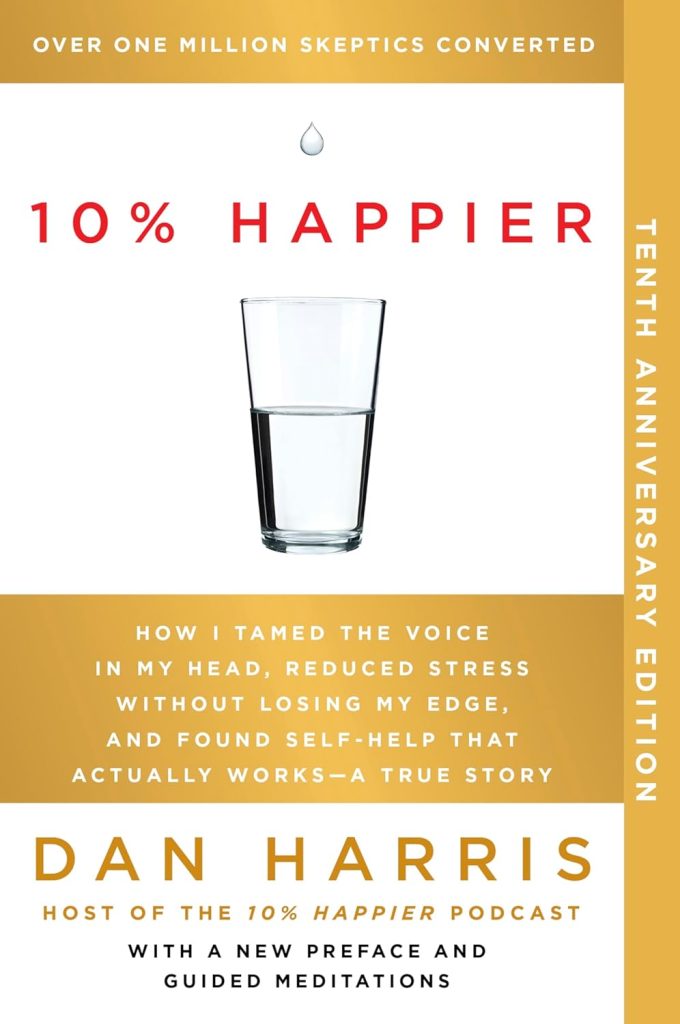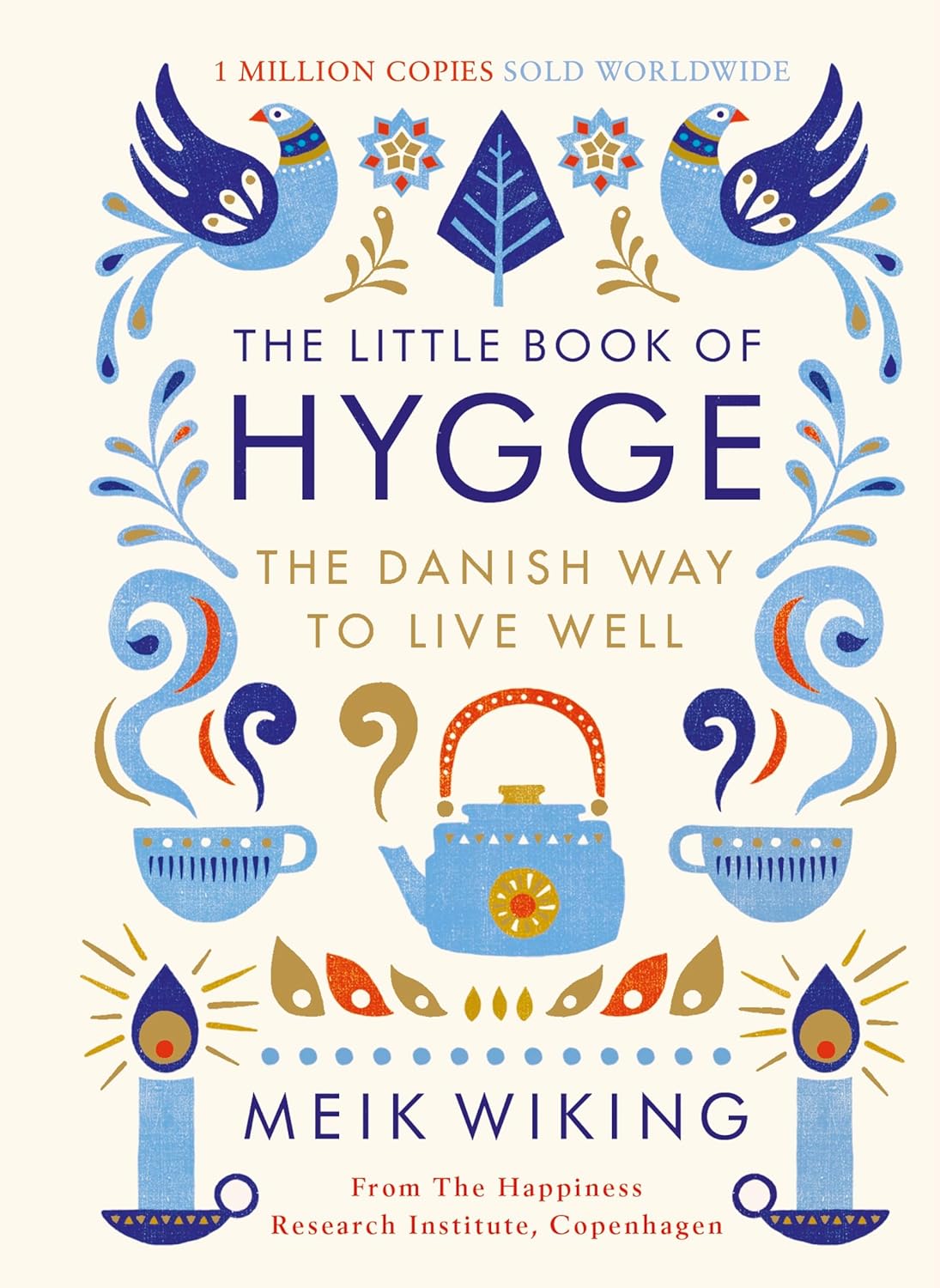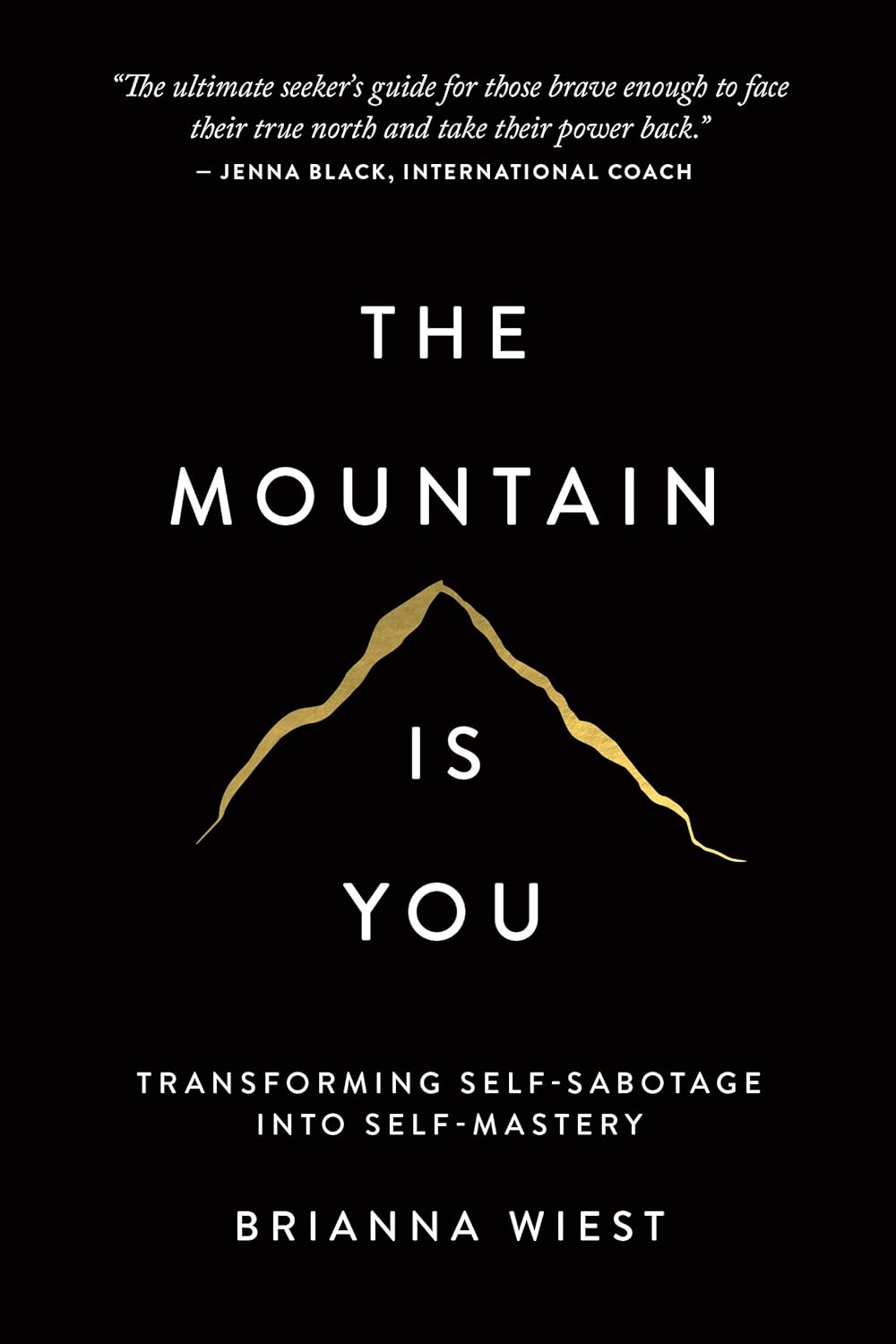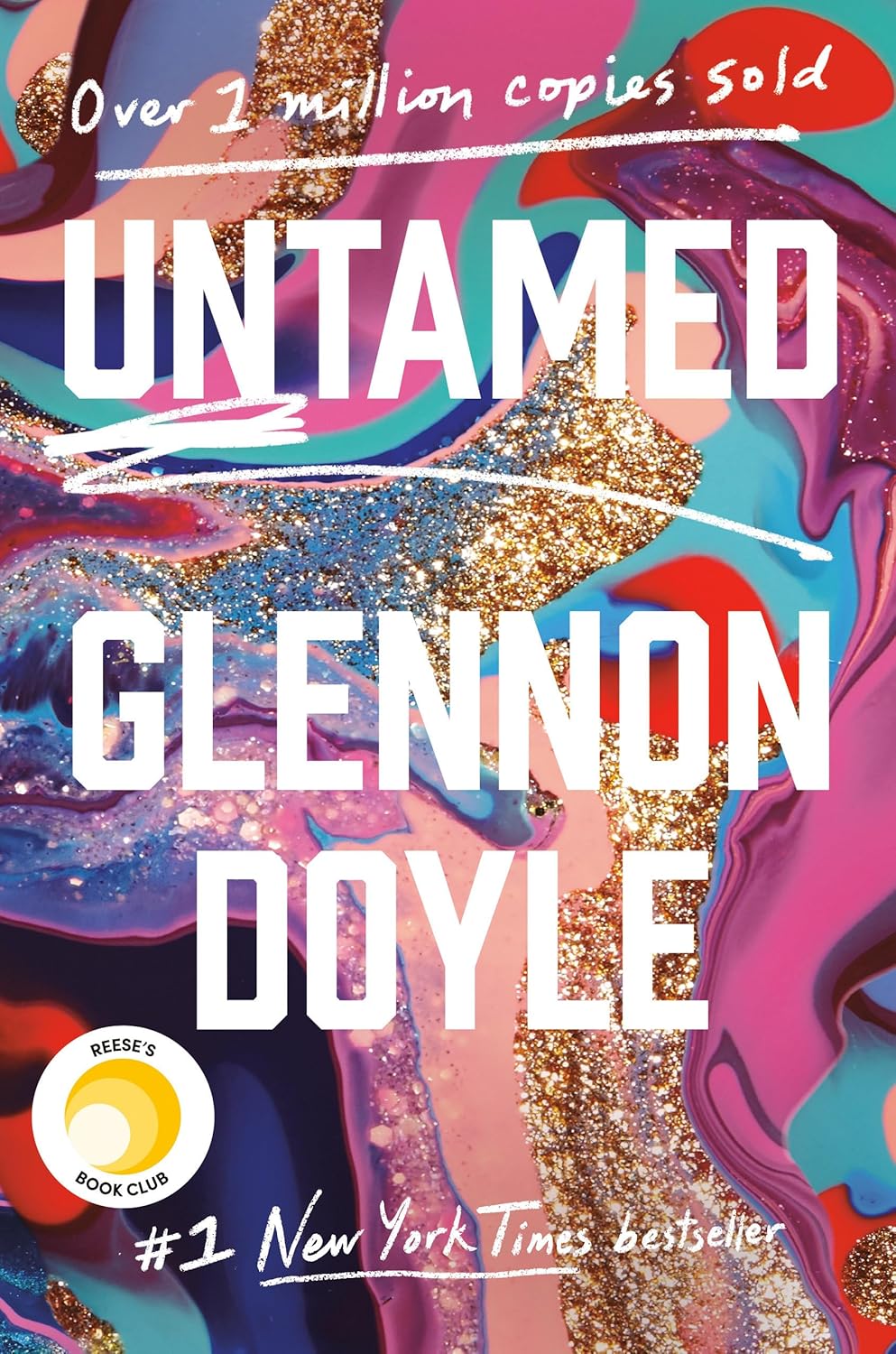
Buy The Book
10% Happier

About
10% Happier is a memoir by Dan Harris, a prominent journalist and news anchor known for his work on ABC News. Harris, who initially viewed meditation with skepticism, embarks on a personal journey after experiencing a panic attack on live television. The book chronicles his exploration of mindfulness and meditation as tools to manage anxiety and stress in a high-pressure career. Harris candidly shares his struggles with self-doubt, ambition, and a critical internal voice, offering readers an insightful look into the challenges of maintaining mental health in a competitive environment.
Harris’s writing is engaging and often humorous, as he demystifies meditation for skeptics, emphasizing its practical benefits rather than spiritual connotations. Through personal anecdotes and scientific research, he argues that meditation can lead to a modest but meaningful improvement in happiness and emotional resilience. The book also explores the broader implications of mindfulness, suggesting that small shifts in awareness can lead to significant changes in one’s approach to life.
10% Happier is both a compelling narrative and a practical guide, encouraging readers to consider mindfulness as an accessible tool for enhancing well-being, regardless of their skepticism or initial reservations.

Spark
Learn
Review
✦ Air Hunger
On June 7, 2004, during a live broadcast of Good Morning America, I experienced a public panic attack with over five million viewers watching. Sitting in for Robin Roberts, I was supposed to deliver news updates. As I began the second story, an overwhelming wave of panic hit me. My heart raced, my mouth went dry, and I felt paralyzed with fear. I tried to push through, but my speech faltered as the panic escalated. The transcript revealed my descent into incoherence: “cancer production” was just one of the many jumbled phrases I uttered.
This meltdown was the culmination of relentless ambition and mindlessness that began when I joined ABC News on March 13, 2000. I was young, ambitious, and eager to prove myself, but the pressure was intense. My first day at ABC, I felt like an imposter among the pictures of news legends like Peter Jennings, whom I idolized. In an unexpected twist, I was hired to co-anchor the overnight show World News Now, but ended up reporting for World News Tonight instead.
Peter Jennings became both a mentor and a challenge. Known for his exacting standards, he pushed me to improve my reporting. However, his temper and unpredictable mood swings often made working with him a daunting experience. Despite this, I was determined to succeed and embraced the intensity of the job, working tirelessly to secure my place in the network.
My determination to excel led me to neglect balance, focusing on my career at the expense of everything else. The competitive environment at ABC only fueled my insecurities, leading to constant self-criticism and stress. Ultimately, this relentless drive and lack of mindfulness culminated in the panic attack on live television, a stark reminder of the need for balance and self-awareness.
✦ Unchurched
In my journey through the world of network news, a particularly transformative phase began as I explored spirituality and religion, areas I had long considered irrelevant or even slightly absurd. Growing up with a Jewish father and a non-religious mother, my family didn’t adhere to any specific religious practices. My parents were scientists, and our household was more focused on rationality and pragmatism than on spiritual matters.
Despite my skepticism, I found myself intrigued by the concept of spirituality while reporting on religious topics. This curiosity was sparked when I covered the rise of megachurches in America, a phenomenon that seemed to blend entertainment and faith in a way that captivated massive audiences. I was struck by the charisma of the pastors, who combined biblical teachings with elements of self-help, drawing in thousands of followers.
One particular assignment took me to Houston, where I met Joel Osteen, the pastor of Lakewood Church, one of the largest megachurches in the country. Osteen’s message was uplifting and positive, focusing on prosperity and personal empowerment. While I initially ap proached the story with journalistic skepticism, I couldn’t help but be impressed by Osteen’s ability to connect with people and offer them hope.
My exposure to these religious environments challenged my preconceptions and prompted me to consider the role of faith in people’s lives. I began to see that, despite my initial doubts, there was something undeniably powerful about the communal and transformative aspects of religion. This newfound openness to spirituality set the stage for my subsequent encounters with meditation and mindfulness, which would later become pivotal in my personal and professional growth.
In essence, my exploration of religion, though unexpected, opened my eyes to the diverse ways people seek meaning and fulfillment, ultimately influencing my path toward meditation and self-discovery.
✦ Genius or Lunatic?
Meeting Eckhart Tolle was a pivotal moment in my exploration of spirituality. Known for his book “The Power of Now,” Tolle exuded a calm presence that was both intriguing and puzzling. During our interview, he spoke about transcending the ego and living in the present moment, concepts that challenged my fast-paced, anxiety-driven lifestyle. Tolle’s ideas about the “voice in the head” not being an inherent part of our identity resonated with me, suggesting a path to personal transformation.
After our encounter, I found myself contemplating whether Tolle was a genius or simply eccentric. His teachings offered a radical shift in perspective, urging me to question my assumptions about consciousness and happiness. While his philosophy seemed abstract, the emphasis on self-awareness and mindfulness aligned with my growing desire for change.
This meeting marked a crucial point in my journey, prompting deeper curiosity about meditation and its potential to manage the incessant chatter of the mind. Tolle’s focus on the present moment became a cornerstone in my evolving understanding of mindfulness, offering a glimpse into a life less dominated by stress and ambition.
Despite initial skepticism, I began to see Tolle’s influence as a doorway to exploring mindfulness more seriously. His ideas encouraged me to reconsider the nature of happiness and success, not as destinations but as states of being accessible through awareness. This encounter was transformative, highlighting the importance of living in the present and the potential for meditation to foster a more balanced existence.
In essence, Tolle’s teachings nudged me toward a journey of self-discovery and spiritual growth, emphasizing the power of mindfulness to navigate the complexities of modern life. This meeting spurred my ongoing quest to understand and integrate meditation into my life, paving the way for personal and professional transformation.
✦ Happiness, Inc.
Happiness, incorporated
Venturing into the self-help industry revealed a world dedicated to the pursuit of happiness, filled with seminars, books, and charismatic speakers. This booming business promised fulfillment through various philosophies and techniques, capturing the attention of those seeking personal growth. Visiting a popular self-help organization, I witnessed the fervor of attendees eager to gain control over their destinies. The atmosphere was a mix of motivational rally and corporate seminar, where positive thinking and visualization were touted as keys to success.
While observing these events, a common thread emerged: a deep desire for empowerment and change. Many participants believed that by altering their mindset, they could transform their lives. Despite some aspects appearing overly simplistic, the genuine enthusiasm and hope of those involved were undeniable.
Amidst this exploration, critics raised concerns about the self-help industry’s potential to exploit vulnerable individuals by offering false hope. This critique resonated with me, prompting a careful consideration of the effectiveness of these programs. However, for many, these teachings provided meaningful frameworks for personal development.
The self-help landscape was complex, blending genuine insights with questionable practices. It highlighted the human yearning for happiness and the lengths people would go to achieve it. This exploration underscored the need for practical tools like mindfulness and meditation, which offered tangible benefits amidst the noise of self-help promises.
Ultimately, delving into Happiness, Inc. was a reminder of the diverse approaches people take in their quest for fulfillment. It fueled my search for a balanced path to mindfulness, one that could provide real, lasting change. This understanding reinforced the importance of meditation as a practical tool for navigating life’s challenges, offering a grounded approach to achieving a more balanced and fulfilling life.
✦ The Jew-Bu
Exploring the intersection of Judaism and Buddhism, humorously termed “Jew-Bu,” offered a fascinating blend of cultural and spiritual practices. This hybrid path intrigued those who, like me, were raised in Jewish households but sought deeper spiritual fulfillment beyond traditional religious practices. Individuals identifying as Jew-Bus found that Buddhism’s emphasis on meditation and mindfulness complemented their Jewish heritage, providing tools for addressing life’s challenges.
Encounters with notable Jewish Buddhists, such as Rabbi Alan Lew, revealed how meditation could enhance, rather than contradict, Jewish beliefs. Rabbi Lew spoke of meditation as a way to connect with the divine and one’s inner self, framing it as an enriching practice. This perspective resonated deeply, demystifying meditation and making it an accessible tool for self-discovery and resilience.
Embracing the Jew-Bu approach offered a way to reconcile analytical and spiritual aspects of identity. It encouraged viewing spirituality as a personal, evolving journey, not confined to rigid doctrines. This hybrid path allowed for appreciation of mindfulness practices while honoring cultural roots, highlighting the flexibility and inclusiveness of spiritual exploration.
For me, the Jew-Bu experience became a stepping stone on the path to mindfulness, helping to view meditation as a practical tool for enhancing well-being. It demonstrated that spiritual practices could be dynamic and adaptable, fostering a deeper understanding of oneself and the world. The Jew-Bu path underscored the idea that spirituality could be personalized, integrating diverse traditions to create a more meaningful and fulfilling life journey.
In essence, the Jew-Bu journey illustrated the possibility of blending traditions to enrich spiritual understanding, paving the way for ongoing exploration of mindfulness and its potential to transform both personal and professional life.
✦ The Power of Negative Thinking
In a culture dominated by the pursuit of positivity, the unexpected value of negative thinking emerged as a powerful tool for resilience and happiness. Instead of succumbing to the pressure of constant optimism, embracing negative emotions and thoughts provided a healthier approach to life’s challenges. The relentless focus on positivity often seemed disingenuous, leaving little room for acknowledging genuine fears and anxieties.
Experts advocating for the acceptance of negative thoughts emphasized the importance of confronting and understanding them rather than suppressing them. This approach allowed individuals to process emotions, learn from experiences, and ultimately move forward more effectively. Aligning with my journalistic instincts for honesty and authenticity, this perspective offered a refreshing alternative to the often superficial positivity prevalent in self-help circles.
Through meditation and mindfulness, the practice of acknowledging negative thoughts without judgment became a transformative experience. This process wasn’t about dwelling in negativity but observing it with curiosity and detachment. By facing these thoughts head-on, their power diminished, leading to a clearer perspective and greater emotional balance.
This shift in mindset provided a liberating sense of acceptance and resilience. It allowed for a more balanced approach to challenges, embracing negative emotions as a natural part of life. By integrating negativity into a broader understanding of the human experience, a deeper sense of peace and contentment emerged.
The power of negative thinking became a cornerstone of a more balanced path to happiness. It highlighted the importance of embracing the full spectrum of emotions, acknowledging that life’s challenges could be navigated with equanimity and grace. This perspective offered a realistic and sustainable approach to personal growth, underscoring the value of mindfulness in fostering a resilient and fulfilling life.
✦ Retreat
Deciding to attend a meditation retreat marked a significant shift in my journey toward mindfulness. Initially, the idea of immersing myself in silence and introspection seemed daunting, but the promise of stepping away from the chaos of daily life was compelling. The retreat provided an opportunity to reset and gain clarity, away from the constant demands of my career.
Upon arrival, the first few days were challenging. The unfamiliarity of silence and the absence of distractions brought discomfort as I confronted emotions I had long avoided. My mind raced with thoughts, and I struggled to adapt to the retreat’s austere environment. However, as days progressed, a gradual shift occurred. The structure of the retreat, with its guided meditations and teachings, offered a supportive framework for introspection.
The absence of external stimuli allowed for deeper exploration of thoughts and emotions. Layers of tension and stress, previously unacknowledged, surfaced. Sitting with discomfort and observing thoughts without judgment became a practice of acceptance and patience. This newfound awareness helped cultivate a sense of clarity and inner peace.
Returning from the retreat, I carried a renewed sense of purpose and commitment to mindfulness in daily life. The experience reinforced the value of stepping away from the noise to gain perspective and foster lasting change. It underscored the power of silence and reflection in cultivating resilience and equanimity.
The retreat became a cornerstone of my journey, highlighting the transformative potential of mindfulness practices. It demonstrated that even brief periods of introspection could provide profound insights and contribute to a more balanced and fulfilling life. This experience affirmed the importance of integrating meditation into my routine, offering a practical tool for navigating the complexities of modern living with greater ease and awareness.
✦ 10% Happier
The concept of becoming “10% Happier” through meditation emerged as a guiding principle that was both attainable and transformative. This realistic promise provided a practical approach to self-improvement, emphasizing incremental progress rather than drastic change. In practicing meditation, subtle yet meaningful shifts in mindset and behavior became apparent, offering a buffer against the stresses and anxieties of daily life.
Rather than eliminating these challenges, meditation provided tools to manage them more effectively. The practice cultivated a sense of calm and focus, enabling a more balanced approach to personal and professional obstacles. This modest improvement validated the idea that happiness and well-being were not destinations but ongoing journeys, achievable through consistent mindfulness.
Sharing the 10% Happier philosophy resonated widely, demystifying meditation for skeptics and newcomers. It dispelled the myth that profound transformation required radical lifestyle changes, promoting the idea that even small enhancements in mindfulness could lead to significant benefits over time.
The simplicity of this approach encouraged continued exploration of meditation and its applications. It became a tool for managing stress, enhancing productivity, and fostering better relationships. The practice didn’t promise perfection but offered a path to becoming a little more present, a little more patient, and, importantly, a little happier.
Ultimately, the 10% Happier journey encapsulated the essence of mindfulness: a series of small, consistent steps toward a more balanced and fulfilling life. It reinforced the notion that personal growth could be accessible and sustainable, achievable through the cultivation of self-awareness and mindfulness practices. This approach to meditation provided a grounded path, emphasizing the power of incremental change in enhancing overall well-being and satisfaction in life.
✦ ”The New Caffeine”
Meditation became a powerful substitute for caffeine, offering a sustainable boost that surpassed the temporary energy jolt of coffee. In the high-pressure environment of network news, caffeine had been my go-to for maintaining alertness during long, demanding days. However, its effects were fleeting, often leaving me jittery and exhausted. In contrast, meditation provided a lasting clarity that sharpened my focus and enhanced my ability to tackle complex tasks.
Scientific research supported these observations, highlighting meditation’s capacity to rewire the brain, improving concentration and reducing stress. As I integrated mindfulness into my daily routine, these benefits became increasingly evident. Meditation sharpened my attention and provided a calm, centered state that allowed for more efficient and effective work.
Beyond professional performance, meditation enriched my personal life. It fostered patience and presence in my interactions, enhancing relationships with family and friends. This newfound awareness allowed for more meaningful engagement, contributing to a greater sense of overall well-being.
Transitioning from a reliance on caffeine to a meditation practice was not without its challenges. Establishing a consistent routine required discipline and commitment. However, the rewards were undeniable. Meditation became a cornerstone of my daily life, a tool for maintaining equilibrium amidst the chaos of modern living.
Embracing meditation as the new caffeine transformed my approach to productivity and self-care. It underscored the power of mindfulness to enhance not only professional capabilities but also personal fulfillment. This shift highlighted the potential of meditation to provide a sustainable path to energy, focus, and happiness, offering a more balanced and fulfilling way to navigate the demands of both work and life.
✦ The Self-Interested Case for Not Being a Dick
This passage presents a detailed and reflective narrative about an encounter with the Dalai Lama, juxtaposed with an experience interviewing Paris Hilton. The author begins with a skeptical attitude toward the Dalai Lama, questioning the traditional and somewhat a mystical aspects of Buddhism that he represents. However, during the interview, the Dalai Lama’s openness to scientific inquiry and his humility in admitting to personal flaws lead the author to reassess his preconceived notions.
The Dalai Lama’s insights on compassion, particularly the idea of “wise selfishness,” where being compassionate is beneficial to oneself, resonate with the author. This notion challenges the author’s earlier, more cynical views on the practicality of compassion in a competitive world, leading to a shift in his own approach to life and meditation.
In contrast, the interview with Paris Hilton highlights a different aspect of the author’s journalistic career, where the pursuit of a sensational moment—like Hilton walking out of the interview—conflicts with the more compassionate approach he has started to embrace. This juxtaposition of experiences underscores the complexity of navigating personal growth while remaining engaged in a profession that often values conflict and controversy.
Overall, the passage illustrates the author’s evolving understanding of compassion, the benefits of meditation, and the challenges of integrating these principles into both personal and professional life.
✦ Hide the Zen
Navigating the perception of being “too Zen” in the high-energy world of network news posed a unique challenge. In an environment where intensity and drive were the norm, my mindfulness practices initially seemed at odds with the expectations of colleagues. The newsroom was a place where showing aggression and hustle often equated to competence and seriousness, making my calm demeanor appear out of place.
Despite this skepticism, the benefits of meditation and mindfulness were undeniable. These practices provided a foundation of calmness and focus that enhanced my performance, allowing me to manage stress more effectively and approach tasks with greater clarity. The challenge lay in integrating these practices into my routine without compromising the ambitious edge necessary for success in a competitive field.
To bridge this gap, I learned to subtly incorporate mindfulness into my workday, finding moments for brief meditation or focused breathing exercises. This balance allowed me to maintain my edge while reaping the benefits of mindfulness, ultimately demonstrating that calmness and ambition could coexist.
Over time, the results spoke for themselves. Colleagues began to notice the positive impact of mindfulness on my work and interactions. The initial skepticism gave way to curiosity and even appreciation, as it became evident that mindfulness practices contributed to a more composed and effective approach to challenges. The journey of integrating mindfulness into a demanding career underscored the importance of authenticity and balance. It highlighted that being “Zen” did not mean a lack of ambition, but rather a strategic approach to enhancing both professional and personal well-being. This experience reinforced the value of mindfulness as a tool for navigating the complexities of modern work life, offering a path to greater fulfillment and success.
For People
– Skeptics of Meditation
– TV News Enthusiasts
– Self-Help Seekers
– Mental Health Advocates
– Professionals Facing Burnout
Learn to
– Understanding Meditation’s Practical Benefits
– Improved Focus
– Stress Reduction Techniques
– Insight into Personal Growth
– Balancing Ambition and Contentment









